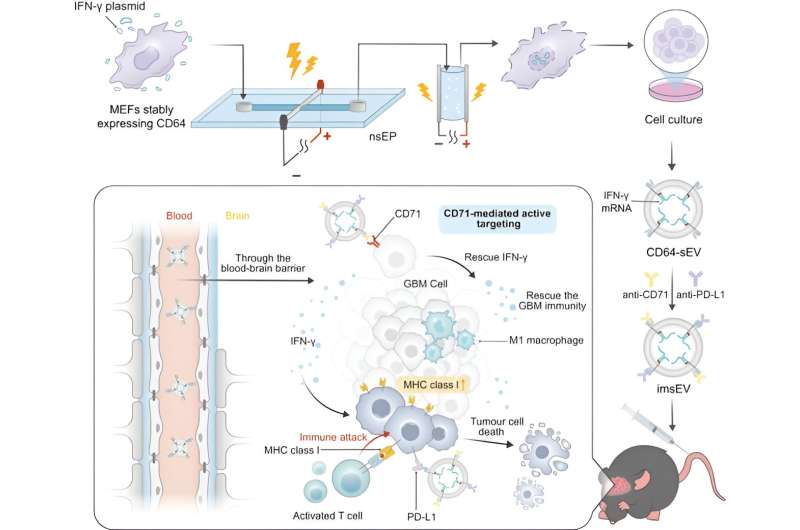This article has been reviewed according to Science X's editorial process and policies. Editors have highlighted the following attributes while ensuring the content's credibility:
fact-checked
peer-reviewed publication
trusted source
proofread
mRNA delivered by extracellular vesicles induces immunotherapy response in glioblastoma

A team of researchers at The University of Texas MD Anderson Cancer Center has developed a new method for using extracellular vesicles to enhance responses to immunotherapy in glioblastoma, potentially opening the door for wider use of engineered messenger RNA (mRNA) for cancer therapy. The study was published today in Nature Communications.
Earlier this year, a team of researchers led by Betty Kim, M.D., Ph.D., and Wen Jiang, M.D., Ph.D., developed a novel method for loading mRNA into extracellular vesicles, small structures created by cells to transport biomolecules and nucleic acids within the body. The current study builds on that research by demonstrating the anti-tumor potential of mRNA-loaded extracellular vesicles.
mRNA therapies, which were recognized by the 2023 Nobel Prize in Physiology or Medicine, have long held breakthrough potential in pathogenic infections as well as diseases like cancer. However, challenges remain to accurately deliver mRNA throughout the body. For years, scientists have studied potential delivery mechanisms, including lipid or polymeric nanoparticles, but each of these has its own limitations.
"There are two primary challenges in using mRNA therapies for cancer treatment. First, how do you accurately target the tumor cells in the body? Second, how do you produce enough of the therapy for human use?" Jiang said. "Our approach solves those two problems."
The quantity problem is solved by using a high-throughput system to produce mRNA-loaded extracellular vesicles from engineered cells. Host cells and a designer plasmid encoding the mRNA are subjected to two extremely short electric pulses, causing membranes inside the cell, as well as the cell membrane itself, to become temporarily permeable. This leads the cells to secrete many extracellular vesicles loaded with mRNA material that can then be collected.
For this study, the researchers engineered the extracellular vesicles to express the CD64 protein on their surface, which serves as a docking mechanism to load both anti-CD71 and anti-PD-L1 antibodies. Once in the body, they seek out CD71 and PD-L1, both of which are commonly overexpressed in glioblastomas.
These extracellular vesicles were loaded with mRNA encoding interferon-gamma, an immune signaling protein. When the vesicles bind to receptors on tumor cells, they are internalized and release the mRNA.
One reason glioblastoma is difficult to treat is that the downregulation of MHC-1, as well as other features of the tumor microenvironment, create an immunosuppressive environment that evades detection and limits the effectiveness of immunotherapies. The mRNA reverses that, changing the tumor microenvironment to make the tumor detectable to the immune system and more responsive to immunotherapies. In the preclinical models, a significant increase in survival time and initial antitumor activity was observed within 7 days of injection.
"We chose glioblastoma because it has limited treatment options currently," Jiang said. "We know that interferon-gamma can induce responses to immunotherapy in glioblastoma, but delivering it to the tumor cells has thus far proven to be a major challenge due to its half-life and the inability for most delivery systems to cross the blood-brain barrier. These results hopefully pave the way for mRNA-loaded extracellular vesicles to be used in cancer applications."
According to Jiang, one of the other advantages of this approach is that it's plug-and-play, meaning it can be adapted to other tumors by simply changing the antibodies to target those overexpressed in other tumor types.
Further preclinical work is ongoing to continue to improve production methods and profile the safety of extracellular vesicles before they are applied in clinical settings.
More information: Shiyan Dong et al, Adaptive design of mRNA-loaded extracellular vesicles for targeted immunotherapy of cancer, Nature Communications (2023). DOI: 10.1038/s41467-023-42365-5
Journal information: Nature Communications
Provided by University of Texas M. D. Anderson Cancer Center




















